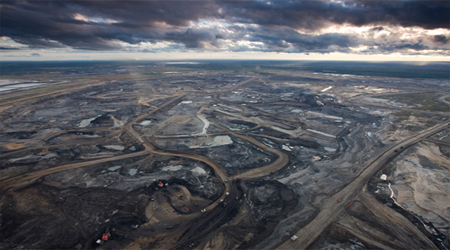 Alberta tar sands are estimated to be 240 GtC (gigatons of carbon); see Intergovernmental Panel on Climate Change (2007) Working Group 3 report. That is about seven times greater than the cumulative historical CO2 emissions from oil use by the U.S. (36 GtC). U.S. oil use was 28% of global oil use for the cumulative amounts over the past 200 years. So Alberta tar sands contain about twice the total amount of carbon emitted by global oil use in history.
Alberta tar sands are estimated to be 240 GtC (gigatons of carbon); see Intergovernmental Panel on Climate Change (2007) Working Group 3 report. That is about seven times greater than the cumulative historical CO2 emissions from oil use by the U.S. (36 GtC). U.S. oil use was 28% of global oil use for the cumulative amounts over the past 200 years. So Alberta tar sands contain about twice the total amount of carbon emitted by global oil use in history.
Yet some people argue that tar sands are not so great that we need to be concerned about their effect on climate. They argue that only about 40 GtC of the tar sands are presently economically extractable. However, if an addiction to tar sands is established, as it would be with big pipelines, you can be confident that the addiction would lead eventually to ways of cooking the oil out of most of the tar sands. Moreover, these numbers do not include the emissions from conventional fossil fuels used to mine and process the tar sands into useable fuel. Nor do they include the other greenhouse gas emissions produced by the mining and processing.
The global stampede to find every possible fossil fuel is not being opposed by governments, no matter how dirty the fuels nor how senseless the energy strategy is from long-term economic and moral perspectives. Instead governments are forcing the public to subsidize the polluters, as discussed in The Case for Young People and Nature.
Fortunately, people are beginning to recognize the situation. Today the Norwegian Grandparent’s Climate Campaign, supported by 27 other organizations, delivered a demand to Statoil (Norwegian government being 2/3 owner of Statoil), the principal tar sands funder, to withdraw support for tar sands development.
Given the stranglehold that the fossil fuel industry has on governments worldwide and their effective campaigns to misinform the public, this may seem to be a small step. But do not underestimate the potential of people dedicated to a righteous cause to initiate a broader public recognition and understanding of where the public’s interest lies.

